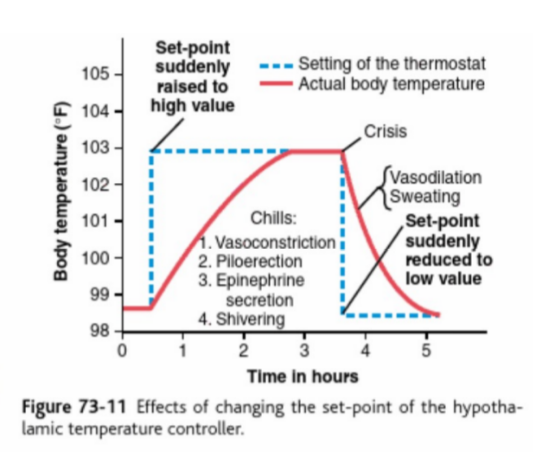Thermoregulation - Intergrative Physiology Lecture 2 Week 11
1/42
There's no tags or description
Looks like no tags are added yet.
Name | Mastery | Learn | Test | Matching | Spaced |
|---|
No study sessions yet.
43 Terms
What two factors drive the thermoregulatory response?
Heat stress and cold stress
WHat are thermoneutral body temperatures for skin and core?
Thermoneutral Core temp = 36-37.5
Thermoneutral Skin temp = 34-35
What is the gold measurement standard for core temperature?
Gold standard:
Eosophageal - temp sensor through nose into esophagus
Ways to measure core temp:
- Tympanic (ear)
- Oral
- Rectal (silver)
- Armpit
What reasons may cause core temperature to fluctuate or differ?
People have natural variation in their core temp neutral range (but not flunctuation)
Fluctuation can be caused by fever, cold stress, heat stress, exercise
What dictates the feeling of thermal comfort?
Skin temperature and Skin thermoreception dictates wether we are comfortable or uncomfortable in heat/enviroment
Which fluctuates more skin temp or core temp and why?
Skin temp is exposed to the enviroment so it fluctuates more then core temperature
What is the main idea of heat balance?
Heat production is exactly equal to Heat loss
THings that create heat production in the body
• Basil metabolic rate
• Muscle activity
• Hormones and neurotransmitter (T3, T4, Cortisol) stimulation
• Thermogenic effect of food (digestion/absorption/storage)
Factors in bodily heat loss
[ CCER ] Conduction, convection, evapouration, radiation,
How rapidly heat can be
conducted from body core to
skin surface
• How rapidly heat can be
transferred from skin to
environment
The heat balance equation: S (body heat storage = X - X - X - X - X - X?
Metabolic rate: exercise is contributed here
External work rate: we can calculate this based on how much people are moving
Radiation: radiative heat loss occurs from body to enviroment (if body is warmer like usual)
Covection: (wind / air velocity)
Conduction: when an object touches another object
Evapouration: from sweat

Relavant themal factors during heat stress and cold stress
Heat: CCER
Cold: CCR
Factors that affect heat transfer factors
• Air velocity
• Air temperature
• Water vapour pressure (affcts the ability of sweat to evapourate - less in high humidity)
• Thermal insulation of clothing
• Vapour permeability / breathability of clothing (affects ability to sweat)
The role of the hypothalamus in regulating temperature
The hypothalamus is the control center
Warm blood —> activate hypothal. heat loss center —> Effectors (sweat glands / vasodillation)
Cool blood —> activate hypothal. heat promotion center —> Effectors (shivering, vasoconstriction)
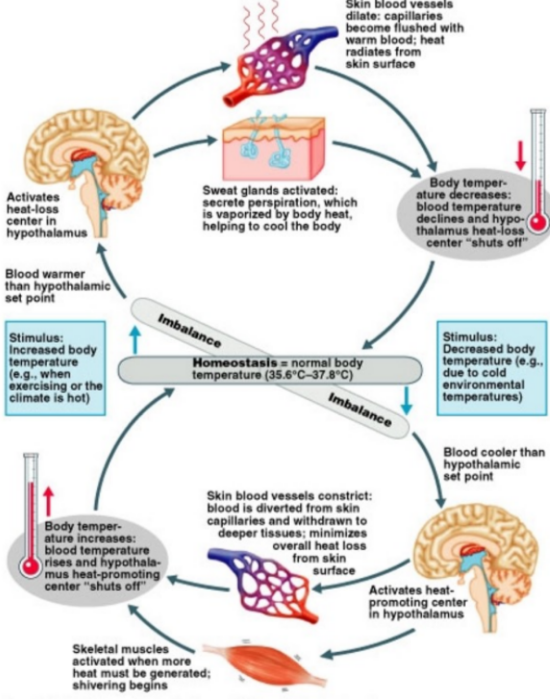
Afferent Feedback to the hypothalamus
Thermoreceptor 1st order neuron —> Warm or cold sensitive sensory neurons are activated —> 2nd order neuron —> lateral parabrachial nucleus —> preoptic area of the hypothalamus —> median preoptic nucleus

What effectors are activated by the hypothalamus in resposne to cold and hot stress?
Brown adipose tissue metabolism [mostly babies / animals] (cold stress)
2. Skin blood flow responses (vasodillation and vasoconstriction )(cold or heat
stress)
3. Sweating responses (heat stress)
4. Increase muscle activity/shivering
thermogenesis (cold stress)
Autonomic thermoeffector activation is [ SELECT: involuntary or voluntary]
Autonomic thermoeffector capacity is [SELECT: infinite or finite]
Autonomic thermoeffector activation is [involuntary]
Autonomic thermoeffector capacity is [ finite] meaning it cant happen forever
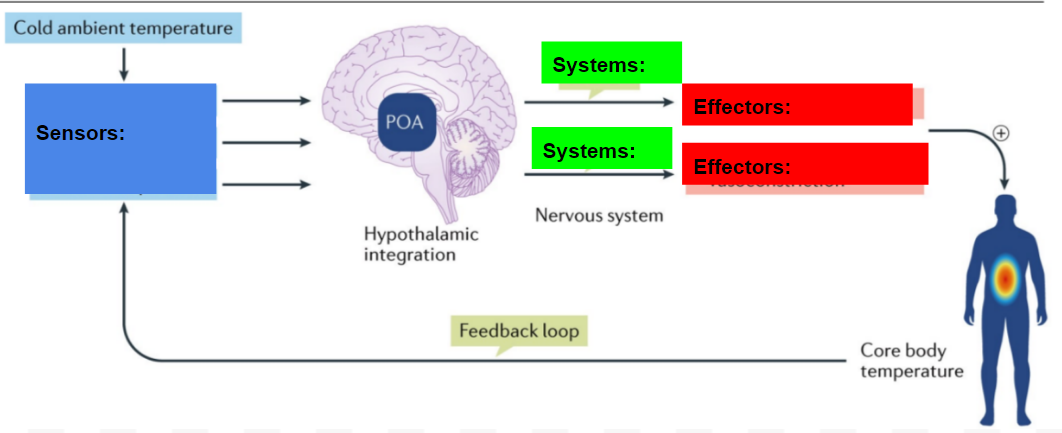
Fill the bank for cold stress response
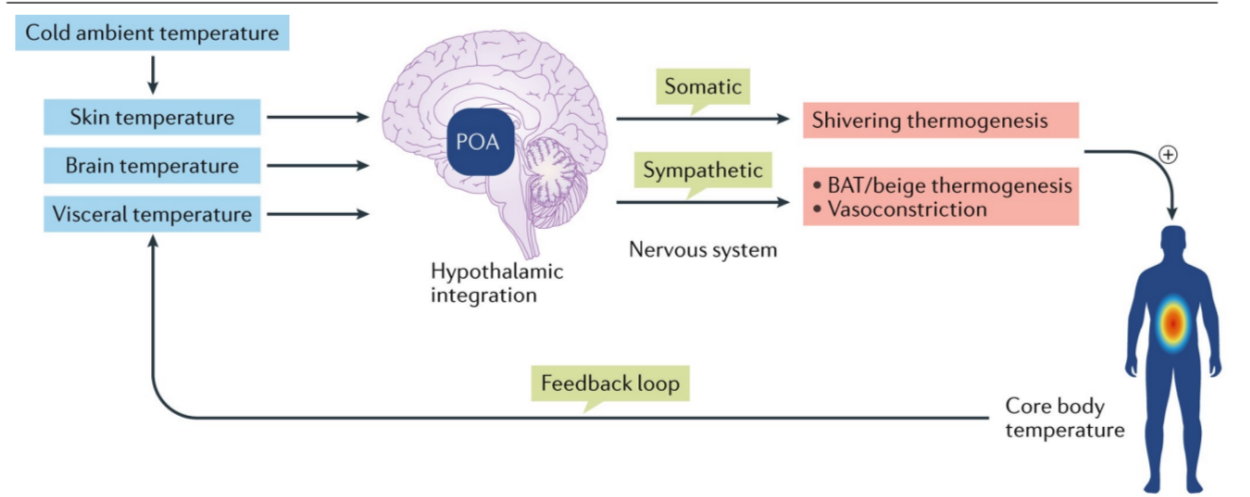
The skin is considered a heat [WHAT] system
The skin is considered a heat radiation system
What does the arteriovenous anastomoses do for heat?
This increases blood flow to the most exposed reigons (e.g. hands and feet). Can bypass capillary beds to conserve heat. Constriction reduces blood flow to extremities
What is the venous plexus and how does it help heat distribution in the body
The venous plexuses are networks of veins located just beneath the skin.
They regulate heat exchange by regulating the amount of blood flow near the skin surface.
They vasodillate and vasoconstrict

Maximal rates of heat produced during involuntary shivering equal approximately [how many times] the Resting metabolic rate?
Shivering is a [somatic or sympathetic] response
Maximal rates of heat produced during involuntary shivering equal approximately 5 times the Resting metabolic rate.
Shivering is somatic and voluntary
If core temperature continues to fall, shivering will eventually [WHAT] at about [WHAT TEMP]
If core temperature continues to fall, shivering will eventually cease at about 31 degrees C).
What is Non-shivering thermogenesis and is it somatic or sympathetic?
Non-shivering thermogenesis is Brown adipose tissue (BAT) activation. It is a sympathetic response to the cold.
How does non-shivering thermogenesis work? Who uses it most? When it is activated
Activation of brown adipose. BAT have very high levels of mitochondria. BAT aids temperature regulation by breaking down glucose for energy and releasing heat.
Mostly BAT is used in babies and animals.
BAT is activated in response to cold as part of the sympathetic response
What is the bodies best defense against the cold?
Voluntary muscular activity (behavioural thermoeffectors)
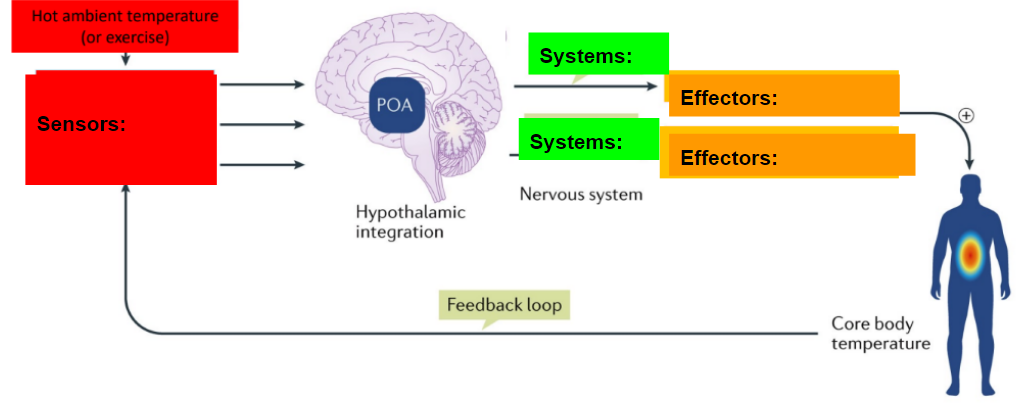
Fill the blanks

During heat stress how much of the blood can be diverted to the skin?
Rate of blood flow to skin can reach upwards of 50% total cardiac output
56-64% of blood is diverted to the skin in sever heat stress
Fully vasodilated vessels can reach [how much] increase in heat conductance compared to vasoconstricted vessels.
Fully vasodilated vessels can reach eight-fold increase in heat conductance compared to vasoconstricted vessels.
What is the most effective heat reducing thermoeffector?
Sweating
[How many] sweat glands on the body surface
[dependent on age, sex, body morphology]
1 litre of vaporized water (e.g., sweat and respiration) transfers [how many] of energy to the environment
It is important to replace [what and what] during heat stress
2 to 4 million sweat glands on the body surface
[dependent on age, sex, body morphology]
1 litre of vaporized water (e.g., sweat and respiration) transfers 580 kcal of energy to the environment
• Important to replace fluids and electrolytes during heat stress
What thermoeffectors sustain human life?
Behavioural thermoeffectors
Behavioural thermoeffector activation is [ SELECT: involuntary or voluntary]
Behavioural thermoeffector capacity is [SELECT: infinite or finite]
Behavioural thermoeffector activation is voluntary
Behavioural thermoeffector capacity is infinite/unlimited
Discriminative component of perception of heat/cold. It is the section of thermal sensation.
Thermal sensation - the objective evaluation of skin temperature (i.e., hot or cold)
This is a binary and objective evaluation
Hedonic component of perception of heat/cold
the feelings surroudning the concious perception. Includes thermal comfort and thermal pleasentness
The two types of hedonic components to heat and cold perception
A state of thermal comfort is a subjective indifference to the enviroment
Thermal plesentness is perceived when a stimulus aims to restore thermal comfort e.g. having a hot shower after a cold day.
Pathway of behavioural thermoregulation and what each section entails
Posterior ventromedial nucleus —> Insula[ thermal sensation - discriminative] —> Orbitofrontal and Cingulata [thermal discomfort] —> Medial prefrontal area [descision to behave e.g. descising to reaching for jacket] — >Supplemental motor —> Motor area [actually send the signals for the behaviour to occur]
PVN —>I—> O —> C —> MPA —> SM —> MA
PVN — IOC — PSA [M]
Pathway of behavioural thermoregulation and what each section entails
Posterior ventromedial nucleus —> Insula[ thermal sensation - discriminative] —> Orbitofrontal and Cingulata [thermal discomfort] —> Medial prefrontal area [descision to behave e.g. descising to reaching for jacket] — >Supplemental motor —> Motor area [actually send the signals for the behaviour to occur]
PVN —>I—> O —> C —> MPA —> SM —> MA
PVN — IOC — PSA [M]
Oder of recruitment of thermoeffectors:
1st = vasoconstriction/vasodillation
2nd = behaviour to restore temp
3rd = sweating/shivering
Heatstroke cause, temp range,
If unable to escape heat, or reduce levels of activity, body temperature will continue to increase
• Leads to greater demands on other physiological systems
• Heatstroke occurs with temp 40-42 degC
Heat stroke effects
1. Blood volume in central body decreases (to go to skin for vasodillation/heat loss)
2. Sweat decreases the blood volume further through water loss
3. This makes the heart beat faster because stroke volume decreases. Heart must work much more to allow oxygen perfusion at tissues
4. Body become dehydrates
5. There is an inflammatory response resulting in cell death and orgam failure
Examples ofpeople who are at increased risk of heat stress / heatstroke
Age related decrements in sweating response
Spinal cord injuries (cant sweat)
Age increases heart conditions
Larger people have greater BMR and SA but often BMR overrides and increases risk of heat stress.
Babies have a large SA to body size making disipating heat significant. They cant do behavioural resonses to heat.
What causes fever
Fever changes the set point in the hypothalamic reigon. E.g. a bacteria may change the hypothalamic set point up a few degrees.
This activates cold stress theromoeffectors to increase body heat (despite not being enviromentally cold).
At some poit we go through crisis where the body recognises the temp is too high causes sweating and vasodillation.
